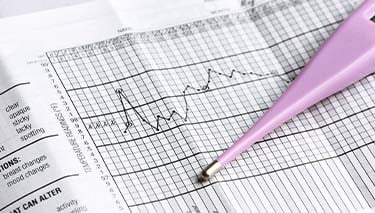Menstruation is the name for the discharge of blood, fluid and mucous from the uterus. The menstrual cycle is influenced by four specific hormones, which govern the monthly process of preparing a woman’s body for pregnancy. Follicle stimulating hormone (F.S.H.) works on preparing the ovarian follicles to support the maturation of an egg, oestrogen is produced by the maturing egg and is at its highest just before ovulation. Luteinizing hormone (L.H.) is the catalyst for ovulation to occur and progesterone thickens the lining of the uterus so it can support the fertilized egg. The most common time frame for a menstrual cycle is around 28 days, but many women have cycles which vary a few days either side of this.
By this age and stage of your life, you are probably well aware of what’s involved in menstruating. Most girls have their first period from around the age of 12 years onwards, making this an outward sign that their body has become (physically) capable of reproducing. Genetics, environment, stress, exercise, nutrition and even body fat to lean muscle ratio all influence the age at which girls start menstruating or having their period.
Why Should I Worry?
Although you may be having a period just now and know you are not pregnant, this is still an important week. Fertilisation commonly occurs around 2 weeks or 14 days after the first day of a woman’s last normal menstrual period (L.N.M.P.). So even though you are not even pregnant yet, don’t underestimate the preparation which is going on as your body equips itself in case conception does occur.
If you do happen to conceive within this month, then the day which you actually started bleeding 2 weeks prior becomes very significant. This is because it provides a very good idea of when fertilisation is likely to have occurred and so your baby’s due date can then be estimated. If you are trying to have a baby, make a point of marking in your diary or on your calendar when you start bleeding each month. Tracking your cycles and becoming more aware of your body’s rhythms is important.
It takes around 5 days for the uterus to shed its lining and then start the process of building up again. Most women aren’t aware of when they ovulate, but they tend to be clearer, for obvious reasons, when they have their period.
Day 1
This is the first day of your period. Although it may not feel like it, your uterus is around the size of a ripe plum and will shed approximately 30ml of blood over the next 5 days or so. This highly muscular organ lies deep in your pelvis and is protected by your pelvic bones and surrounding organs. If you are planning to conceive this month, then start taking folic acid supplements now. The recommendation is for 500mcg per day. This important nutrient has been proven to lower the risk of babies being born with spina bifida and other neural tube defects.
Day 2
This can be the heaviest day of bleeding for many women. It can also be painful as their uterus contracts in its efforts to expel the blood which has built up over the preceding month. Already, eggs are beginning to mature in a number of follicles, but only a lucky one will get to the stage of being ready to “pop” when it is time for you to ovulate. If you’re feeling a little tired and emotional, you’re entitled to. There are so many hormonal changes happening now which have everything to do with biology and preparing your body for possible conception.
Day 3
That maturing egg within its follicle is still sitting tightly in one of your ovaries, just waiting for its turn to come. But meanwhile, your uterus is still shedding its lining – that rich, blood filled environment wasn’t needed to nurture a fertilised egg so your body considers it a waste product. If you have particularly painful, irregular or long periods, then you may benefit from seeing a gynaecologist. This is a doctor with specialist training in menstrual and fertility problems. There are a number of options and treatments available for menorrhagia and dysmennorhoea (heavy and painful periods).
Day 4
You may find you aren’t bleeding as much today and you aren’t as uncomfortable as you’ve been in the prior days. Although this month’s period isn’t even over, your body will already supporting the development of new follicles. Each month, around 15-20 follicles reach maturity, but only one which will eventually release an egg. If two or more are released and are fertilized by your partner’s sperm, then a multiple pregnancy will occur.
Day 5
Your period will be tapering off by now, if you fit the description of the “average” woman. You may want to make some lifestyle changes at this point, to optimise your chances of conceiving and having a healthy pregnancy. Only
Last Published* May, 2024
*Please note that the published date may not be the same as the date that the content was created and that information above may have changed since.





















